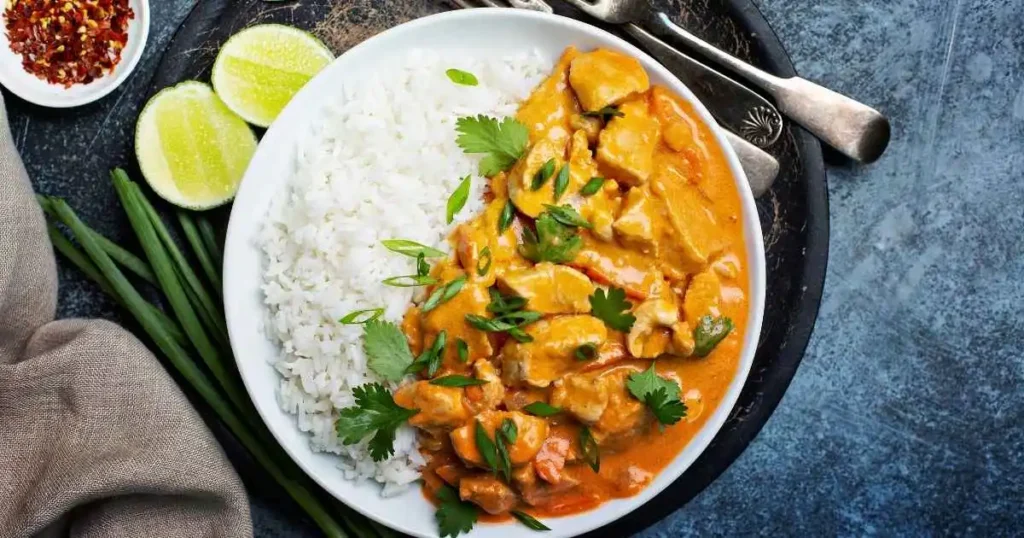As the aroma of simmering coconut milk and spices fills your kitchen, you’ll feel like you’re in Thailand. The flavors in this authentic Thai chicken curry recipe are so enticing that you’ll want more. This easy recipe is perfect for both seasoned cooks and beginners, letting you make a delicious dish at home.
Picture tender chicken in a creamy coconut curry sauce, with hints of ginger, garlic, and Thai spices. This dish is quick to make, ready in under an hour. It’s great for busy nights or special occasions. With just a few ingredients, you can enjoy the vibrant tastes of Thailand from your kitchen.
Understanding Thai Curry Essentials
To enjoy authentic Thai chicken curry, knowing the key ingredients is key. The aromatic pastes and creamy coconut milk are crucial. Each part adds to the dish’s sweet, sour, spicy, and savory flavors.
1.Types of Thai Curry Pastes
Thai curries have different colors and tastes. Red curry paste uses up to 20 red chilies for a fiery kick. Green curry paste is known for its fragrant mix of lemongrass, galangal, and kaffir lime. Yellow curry paste is milder and sweeter.
2.Role of Coconut Milk in Thai Curries
Coconut milk is essential for Thai curries. It makes the dish creamy and coats the ingredients well. Choosing high-quality coconut milk is important for the best flavor.
3.Essential Thai Curry Seasonings
Lemongrass, galangal, and kaffir lime leaves are vital. They add unique aromas and flavors. Together, they create the complex tastes that make Thai food special.
Knowing the essential ingredients helps you make delicious Thai chicken curry at home.
Thai Chicken Curry: A Traditional Favorite
Discover the world of Thai chicken curry, a dish loved in Thailand and worldwide. It mixes tender chicken with a creamy, spicy sauce. This mix of sweet, sour, salty, and spicy flavors is perfect.
Thai curries are different from Indian ones because they’re soupy. This lets the flavors stand out. You can enjoy it with rice, quinoa, or bread, making it easy for everyone.
| Recipe Rating | Servings | Preparation Time | Cooking Time | Total Time |
|---|---|---|---|---|
| 4.90 stars out of 5 (234 reviews) | 6 people | 10 minutes | 22 minutes | 32 minutes |
The Thai chicken curry recipe lets you try different proteins. You can use chicken, fish, shrimp, or even beef. Add fresh veggies like carrots and broccoli for extra flavor.
For a real Thai curry taste, use top-quality ingredients. Choose Thai red curry paste from brands like Mae Ploy. Full-fat coconut milk makes the curry creamy and rich.
Garlic, ginger, onions, and lemongrass add depth to the curry. Fish sauce, soy sauce, and brown sugar balance the flavors.
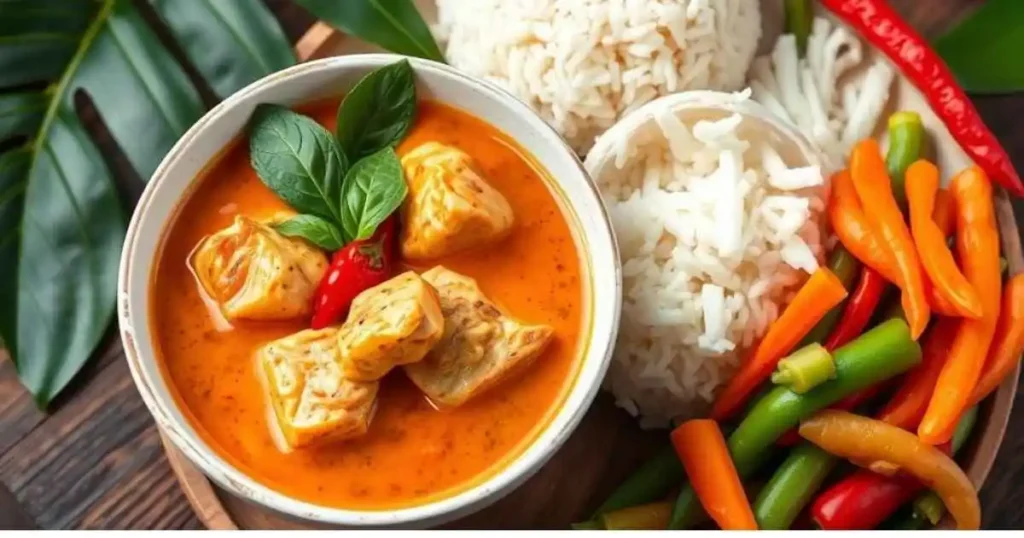
Whether you’re experienced or new to cooking, this authentic Thai chicken curry recipe will impress you. It brings the flavors of Thailand right to your table. Enjoy this traditional dish and its complex tastes.
Key Ingredients for the Perfect Curry
Making a real Thai chicken curry needs the right ingredients. From the chicken cut to the coconut milk, each part is key. They all work together to get the flavors just right.
1.Choosing the Right Chicken Cut
For the best taste and texture, use boneless, skinless chicken breasts or thighs. This type of chicken lets the curry flavors soak in well. The tender thigh meat also makes the dish feel richer in your mouth.
2.Fresh vs Dried Herbs and Spices
Fresh herbs and spices are always better. Fresh ginger, garlic, and cilantro give the curry a lively and aromatic taste. While dried spices like cumin and coriander are good, fresh ones make the flavor even better.
3.Selecting Quality Coconut Milk
The heart of a Thai curry is high-quality coconut milk. Choose brands with lots of coconut solids and no added preservatives. Mae Ploy or Chaokoh are great for a creamy and authentic curry.
| Ingredient | Recommended Brand | Ratio of Coconut Solids to Water | Additives |
|---|---|---|---|
| Coconut Milk | Mae Ploy | High | None |
| Coconut Milk | Chaokoh | High | None |
With these key ingredients, you’re set for a fantastic boneless skinless chicken Thai curry. It will truly taste like it’s from Thailand.
Essential Kitchen Tools and Equipment
Creating an authentic Thai chicken curry needs the right tools. A good skillet or ovenproof pan is key for searing chicken and simmering the curry. A sharp chef’s knife is vital for chopping veggies and herbs, adding fresh flavors.
Other useful tools include a strong wooden spoon for stirring and a set of measuring cups and spoons for accurate ingredient amounts. Also, a reliable can opener is needed for the coconut milk, which adds creaminess.
With these tools, you’ll make a Thai chicken curry full of rich, aromatic flavors. Quality equipment leads to an exceptional dish.
Preparation Tips and Techniques
To make a real Thai chicken curry, you need to prepare the ingredients right. Let’s look at the key techniques for a flavorful and tasty dish.
1.Proper Chicken Preparation
For the best texture, slice the thinly sliced chicken breasts or thighs thinly. This helps the meat cook evenly and soak up the curry paste and coconut milk. Use a sharp knife or mandoline to get even slices.
2.Vegetable Cutting Techniques
For the vegetable preparation, cut all vegetables the same size. Dice onions, bell peppers, and more into similar pieces. This way, they cook evenly and don’t get overcooked or undercooked.
3.Curry Paste Activation Methods
To bring out the curry paste frying flavor, start by heating it gently in oil. Stir constantly. This lets the spices and aromatics bloom, releasing their oils and making the dish taste better.
| Preparation Step | Technique | Why It Matters |
|---|---|---|
| Chicken Slicing | Thin, even slices | Ensures even cooking and optimal flavor absorption |
| Vegetable Cutting | Uniform, consistent pieces | Promotes even cooking and texture throughout the dish |
| Curry Paste Activation | Gently frying in oil | Unlocks the full flavor potential of the curry paste |
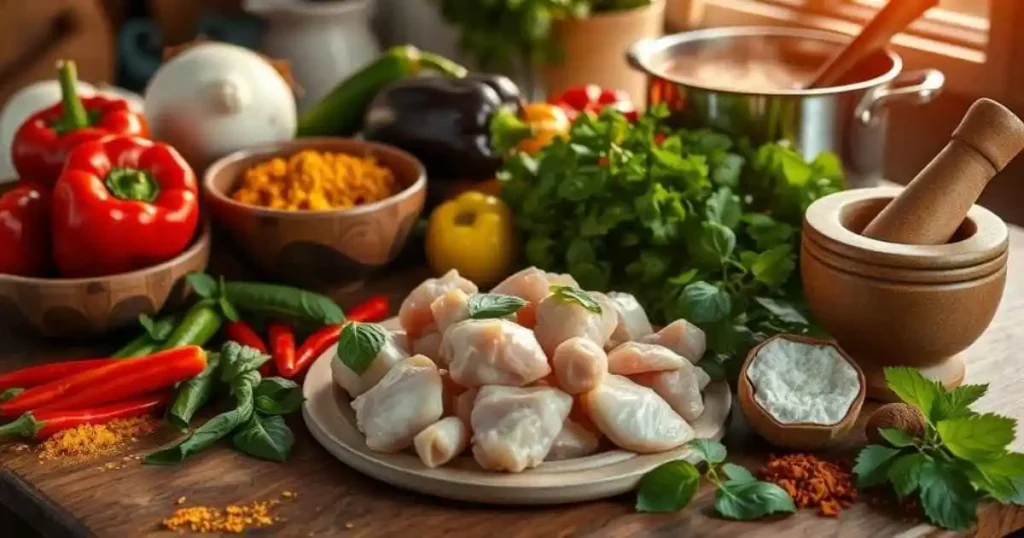
By using these tips and techniques, you’ll make a delicious Thai chicken curry. It will surely please your taste buds.
Step-by-Step Cooking Process
Make a delicious Thai chicken curry quickly with this simple recipe. Start by searing the chicken in a big skillet or wok until it’s golden brown. This takes about 5-7 minutes. Then, take the chicken out of the pan and set it aside.
Next, sauté the vegetables like onions, garlic, ginger, and colorful bell peppers or green beans. Cook them for 2-3 minutes until they smell great. After that, add the red curry paste and stir it for 1-2 minutes. This helps release the flavors.
- Pour in the creamy coconut milk and let it simmer.
- Put the seared chicken back in the pan. Let it simmer for 8-10 minutes. This makes the chicken and vegetables tender.
- Check the curry’s taste and adjust the seasoning. Add fish sauce, brown sugar, or red pepper flakes to get the flavor right.
Just before serving, stir in the fresh basil leaves. This adds a bright, aromatic touch to your Thai chicken curry. Serve it hot over fluffy jasmine or basmati rice for a full Thai meal.
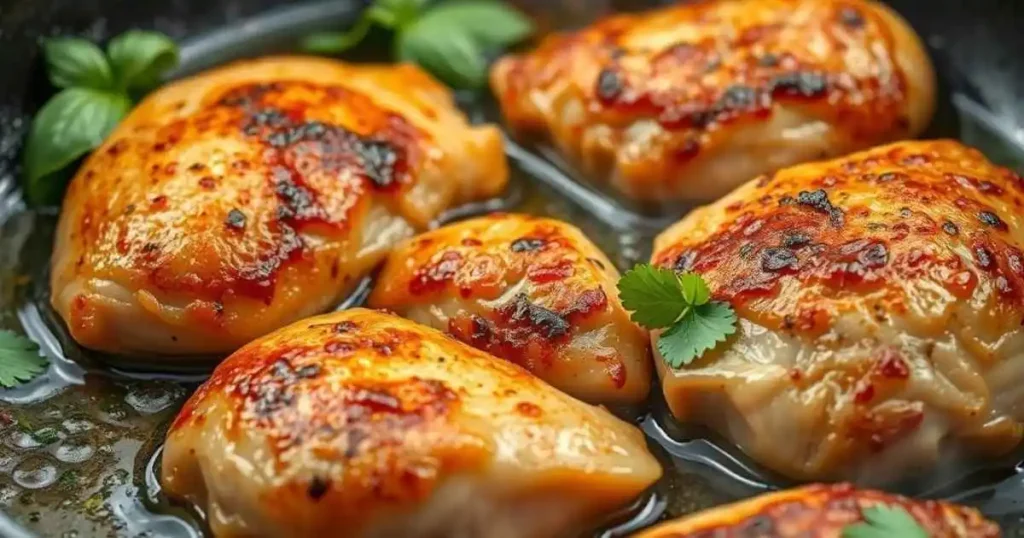
| Ingredient | Quantity |
|---|---|
| Boneless, skinless chicken thighs | 1 pound |
| Olive oil or coconut oil | 2 tablespoons |
| Red curry paste | 1/4 cup |
| Coconut milk | 2 cans (13.5 oz each) |
| Fish sauce | 2 tablespoons |
| Brown sugar | 1 tablespoon |
| Fresh basil leaves | 1 cup, torn |
| Jasmine or basmati rice | 1 cup, cooked |
Balancing Flavors and Spice Levels
Making a real Thai chicken curry is about finding the right mix of sweet, sour, salty, and spicy. It’s all about adjusting the seasonings as you cook.
1.Adjusting Heat and Seasoning
Begin with a good amount of Thai curry paste. It gives the dish its main heat and flavor. If you want it spicier, add more paste. But, it’s hard to make it less spicy once it’s too hot.
Add the right amount of fish sauce for saltiness and sugar for sweetness. Finish with fresh lime juice for a bit of acidity.
2.Traditional Taste Components
- Sweet: From coconut milk and sugar
- Sour: Lime juice or tamarind
- Salty: fish sauce
- Spicy: Thai chilies and curry paste
Keep tasting and adjusting the seasonings. This ensures the flavors work well together. A well-balanced Thai chicken curry is truly special.
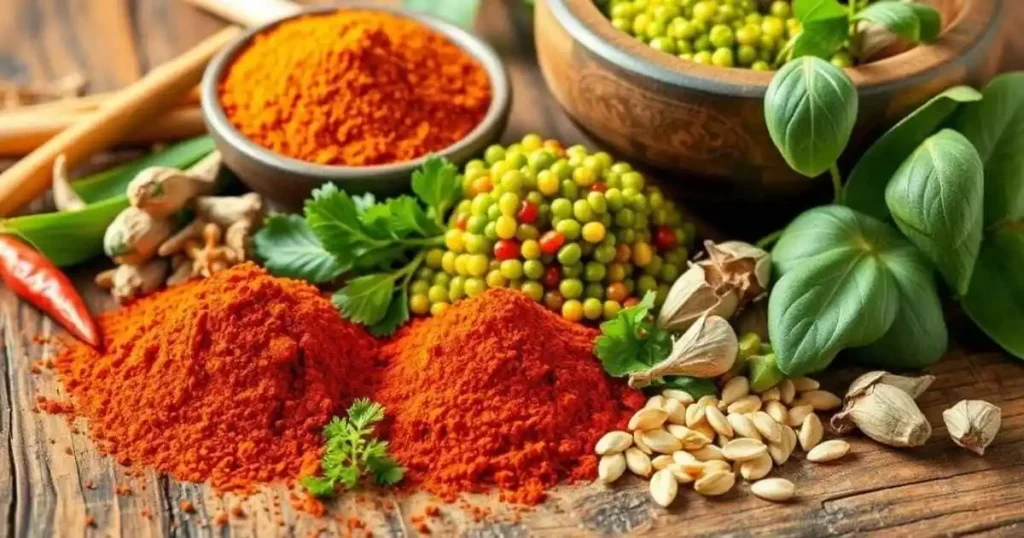
Serving Suggestions and Accompaniments
Make your Thai chicken curry even better by adding some tasty sides. Serve it over jasmine rice or rice noodles. Top it with fresh cilantro and a squeeze of lime wedges for extra flavor.
For a refreshing touch, try adding cucumber, Thai basil leaves, or a zesty papaya salad. These add a nice crunch and balance out the meal.
| Side Dish | Description |
|---|---|
| Lime and Coriander Rice | Fragrant jasmine rice infused with fresh lime and cilantro |
| Thai Salad with Sesame Garlic Dressing | Fresh greens, vegetables, and a tangy, nutty dressing |
| Homemade Flatbreads | Soft, pillowy flatbreads that pair perfectly with the curry |
| Pickled Cucumber Salad | Refreshing cucumbers pickled with red chili for a bright contrast |
| Thai Papaya Salad | Shredded green papaya, tomatoes, and a tangy, spicy dressing |
| Lettuce Wraps | Light and crisp lettuce leaves to scoop up the curry |
| Fried Crunchy Peanuts | A simple yet satisfying crunchy topping |
Pairing your Thai chicken curry with these sides will make your lunch meal complete. You’ll feel like you’re dining in Thailand, right in your own home.
Storage and Reheating Guidelines
Storing and reheating your Thai chicken curry right is key to keeping its great taste and texture. Follow these easy steps to keep your leftovers fresh and tasty.
1.Proper Storage Methods
To refrigerate leftovers, put the curry in an airtight container. Store it in the fridge for up to 4 days. This keeps the flavors in and stops the dish from drying out.
Don’t freeze coconut milk-based curries. The coconut milk can separate when thawed, ruining the dish’s texture and taste.
2.Best Reheating Practices
When reheating your Thai chicken curry, reheat it gently. The best way is to heat it on the stovetop, stirring now and then. You can also reheat small portions in the microwave, stirring every 30 seconds to avoid hot spots.
By following these tips, you can enjoy the real taste of your Thai chicken curry even after the first time you eat it.
Common Mistakes to Avoid
When making a real Thai chicken curry, avoid a few common mistakes. One big mistake is overcooking the chicken. This makes it tough and dry. Cook the chicken just right, so it stays juicy.
Don’t use light coconut milk for your curry. It makes the curry too thin and watery. Instead, choose full-fat coconut milk for a richer, creamier taste.
- Don’t add too much curry paste at once. Start with a little and add more if you want it spicier. Too much paste can make it too hot.
- Keep tasting and adjusting the flavors. Everyone likes things a bit different, so tweak the seasonings to your taste.
Avoid these mistakes to make a delicious, authentic Thai chicken curry. It will surely please your taste buds.
| Ingredient | Quantity |
|---|---|
| Chicken Breasts | 1″ dice |
| Coconut Milk | 14oz can, full fat unsweetened |
| Red Curry Paste | 4oz jar |
| Vegetables | 2-3 minutes softened, al dente |
| Cooking Time | 25 minutes total |
Health Benefits and Nutritional Information
Thai chicken curry is packed with health benefits. It’s a rich source of protein, vitamins, and healthy fats. The chicken offers a lot of protein. Bell peppers and other veggies add vitamin C.
The coconut milk in it is full of healthy fats. These fats, like MCTs, help with weight and metabolic health.
This dish can fit into a low-carb diet if you skip the rice. But, it’s high in calories because of the coconut milk. So, it’s best to eat it in moderation.
- Protein-rich dish with lean chicken as the main ingredient
- Loaded with vitamin C from bell peppers and other vegetables
- Provides healthy fats from the use of coconut milk
- Can be part of a low-carb diet when served without rice
- High in calories due to the coconut milk content, requiring moderation
Adding Thai chicken curry to your chicken meals can be a great choice. It’s tasty and good for you. With its mix of protein, healthy fats, and low-carb ingredients, it’s a nutritious addition to any diet.
I’m excited to share this thai chicken curry recipe with you, hoping it will become a cherished tradition.
Conclusion
Making homemade Thai curry at home is easy with the right ingredients and techniques. This versatile recipe lets you adjust spice levels and add your favorite veggies. You can make a restaurant-quality Thai curry that’s just as good as those in Thailand.
To make an authentic Thai curry, know the key ingredients. These include curry pastes, coconut milk, and seasonings. With this knowledge, you can try different proteins and veggies to your liking. You might choose classic chicken, beef, or tofu. The result is a dish full of spices, aromas, and creamy goodness that feels like a trip to Thailand.
Get creative with this versatile Thai curry recipe. Mastering the techniques and flavors lets you bring Thai cuisine home. Share the authentic flavor of Thailand with your loved ones. Start this tasty adventure and improve your cooking with this homemade Thai curry recipe.
Frequently Asked Questions
What is Thai Chicken Curry?
Thai Chicken Curry is a healthy, one-pan dishes that’s easy to make and delicious. It has a rich coconut sauce with ginger, garlic, and authentic Thai curry flavor.
What types of Thai curry are there?
Thai curries include red, green, and yellow types. Red curry paste is key in Thai red chicken curry.
What is the role of coconut milk in Thai curries?
Full-fat coconut milk makes the sauce thick and creamy. The quality of coconut milk greatly affects the curry’s taste and texture.
What are the essential seasonings in Thai Chicken Curry?
Important seasonings are lemongrass, galangal, and kaffir lime leaves. They add authentic Thai curry flavor.
What type of chicken is best for Thai Chicken Curry?
Use boneless, skinless chicken breasts or thighs. Thinly slice the chicken for even cooking.
What kind of coconut milk should I use?
Choose coconut milk with high solids and no additives. Brands like Mae Anong or Mae Ploy Yellow Curry Paste are good choices.
What kitchen tools are needed for making Thai Chicken Curry?
You’ll need a good skillet or ovenproof pan, a sharp knife, a wooden spoon, and measuring tools. Also, a can opener for the coconut milk.
How do I prepare the vegetables for Thai Chicken Curry?
Cut vegetables like bell peppers and onions evenly for consistent cooking.
How do I activate the curry paste?
Fry the curry paste in oil before adding other ingredients. This enhances its flavors and aromas.
How do I balance the flavors in Thai Chicken Curry?
Use fish sauce for saltiness, sugar for sweetness, and lime juice for acidity. Adjust spice levels by changing the curry paste amount.
How should I store and reheat leftover Thai Chicken Curry?
Store leftover curry in an airtight container in the fridge for up to 4 days. Reheat gently on the stovetop or in a microwave, stirring often.
What common mistakes should I avoid when making Thai Chicken Curry?
Don’t overcook the chicken, use full-fat coconut milk, and add curry paste gradually. Too much paste can make it too spicy.
What are the health benefits of Thai Chicken Curry?
Thai chicken curry is rich in protein from the chicken. It also has vitamin C from bell peppers and healthy fats from coconut milk

